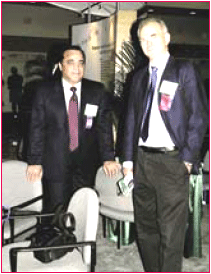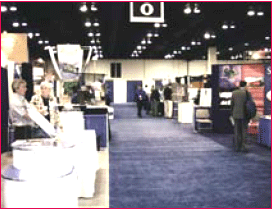| Conference | |
ION GNSS 2006
|
||||
| With activities in the GPS, GLONASS, and Galileo programs in full swing (although not always swinging in a forward direction), the ION Satellite Division’s GNSS 2006 conference rolled into Texas for the first time in its nearly 20-year history. The world’s oldest and largest GNSS conference, the 2006 event featured a Texas-sized line-up of nearly 290 paper presentations in 36 technical sessions — all synchronized to a fare-thee-well by ION’s (in)famous and rigidly enforced traffic-lighting system for speakers. According to Todd Walter, the 2006 program chair, more than 570 abstracts were received and evaluated for this year’s meeting.
Patrick Fenton, chief technology officer for NovAtel, Inc., received the Institute’s coveted Johannes Kepler Award for “sustained and significant contributions to the development of satellite navigation.” The Bradford W. Parkinson Award for the outstanding graduate student in the field of Global Navigation Satellite Systems (GNSS) went to Dr Julien Olivier. ION is riding the wave of a growing familiarity with GPS as a household term and a burgeoning market for GNSS products. GNSS users number in the hundreds of millions already, and market studies predict annuals sales of more than 300 million receivers within five years. And the GNSS community is doing more than just talking about multiple satellite-based systems for positioning, navigation, and time. Even though the European GNSS system has only a single experimental spacecraft in orbit and is years away from completion, this year’s conference included reports on development of Galileo receivers and the demonstration of several (albeit using signal simulators) in the exhibition. GLONASS technology also is appearing in a growing number of GNSS user equipment displayed at the conference.
“Interesting Times”The Tuesday evening plenary session, moderated by Dr Per Enge of Stanford University, got the conference going with a high-level panel speaking under the theme, “We Live in Interesting Times.” Lt. Gen. Michael Hamel, commander of the Space and Missile Systems Center at Los Angeles Air Force Base, addressed the audience in the afterglow of a successful launch the day before of the second modernized Block IIR satellite. Hamel assured his audience that the GPS vision was been well taken care of by a program that is delivering performance better than specified in a “model of government/industry/military institutional cooperation.” Rainer Grohe, executive director of the Galileo Joint Undertaking (GJU), provided an update on the current status and prospects for conclusion of negotiations for a 20-year concession contract with a consortium that will finishing building and operate the Galileo system. Sizing, managing, and allocating the financial risks — particularly of liability exposure for Galileo operations — remains a sticking point in the talks. Carlene Stephens, curator of exhibitions about time at the Smithsonian Institution, described plans for a new exhibition, “Finding Time and Place: From Chronometers to GPS,” that will open in 2010. The Smithsonian is partnering with the U.S. Naval Observatory, which provides the time standard for GPS and the Department of Defense in general. ION has provided seed money for the exhibition and is continuing to support its formative efforts. Kanwar Chadha, cofounder of SiRF Technology, continued his role of itinerant GNSS visionary by predicting that “geosearches” would become as common an activity as Google searches or Yahoo searches on the Internet. Development of new multifunctional platforms incorporating GNSS and other technologies will continue vigorously, according to Chadha. Professor David Last, with an evenhanded skewering of GNSS program foibles of every stripe, undoubtedly got off the best line of the evening in characterizing the interwoven GNSS “signals wrapped intimately around each other, yet never touching. It’s safe sex in the frequency domain.” Brad Parkinson, ION’s long-time Satellite Division chair and author of the quotation sent into space on Block IIR-M(2), closed out the evening’s discussion with a call for a renewed investment in the GPS program and the expansion of the satellite constellation to 30 or more spacecraft. Constellation sustainment is the leading issue facing GPS, Parkinson said, and reprogramming of funds from GPS as a result of the better-than-expected performance of the satellites has made GPS supporters “victims of our own success.” On the exhibition floorNearly 90 exhibitors occupied more than 90 booth spaces and an additional 16 exhibit “islands.” Fully operational Galileo receivers were demonstrated by a few companies, including NordNav, NovAtel, and Septentrio, and several — among them u-blox, Nemerix, others announced Galileo-capable equipment. Topcon announced survey equipment that the company says has tracked GPS, GLONASS, and the Galileo experimental signal on the GIOVE-A satellite launched last December. Reflecting the general trend toward smaller form factors (plus anticipated market growth in portable devices incorporating GNSS, particularly mobile phones), many companies announcednew GPS chips or chipsets. CGSIC warms up the crowdThe Civil GPS Service Interface Committee (CGSIC), held on the two days before GNSS 2006, serves as a sort of warm-up act for ION’s show. Some of the issues that inform and energize the ION conference often get their first hearing in CGSIC sessions. A September 25 panel chaired by US GPS Industry Council executive director Mike Swiek and comprising representatives of three prominent GNSS vendors expressed their frustration and anxiety about the Galileo program’s handling of commercial issues: Javad Ashjaee, CEO of Javad Navigation Systems; Tony Murfin, vice-president for business development at NovAtel, Inc.; Greg Turetzky, SiRF Technology’s marketing director for new product technology and IP; Milton Vaughan, with Agrium Crop Production Services. Their critique reiterated several key points: the specifications of the evolving Galileo signal and system design should be open and freely available for commercial development – preferably unlicensed and without charge or with only a nominal fee, including royalties on receiver chipsets. Further, that the political considerations of the Galileo publicprivate partnership or PPP should not force an unworkable business model on the system’s development. By Glen Gibbons. Reprinted with permission from The Institute of Navigation Fall 2006 Newsletter, Vol. 16, Number 3. |
||||













 (No Ratings Yet)
(No Ratings Yet)





